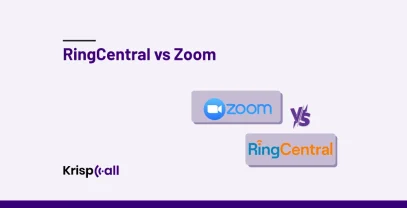Are you tired 😩 of clients waiting for busy phone lines while calling certain departments in your business organization?
There might be many clients 🧑💻 waiting to call so that their problems or queries can be fixed as soon as possible. Is the increased call wait time making clients hang up the phone? If yes, then this blog has a solution for you; it’s called Call Group.
In this blog, we have covered everything you need to know about Call Groups. Furthermore, we will cover important things that will help you facilitate better and faster communication and optimize the proper workload distribution of the caller agents.
🔑 Key Highlights
- Call Groups can answer not only phone calls but also emails, chats, and messages.
- Popular CRM Integration Business Tools HubSpot, Zapier, and PipeDrive are used to optimize call groups.
- Call Group is the best way to improve the Call Routing process in a business organization.
Let’s get started! 🔽
What do you mean by Call Group?
A Call Group 📞 is a specific team of a certain department in a business organization to efficiently and effectively handle incoming calls from clients or customers. Call Group is also known as Ring Group.
It can facilitate better and faster communication with clients and also give a better customer experience. You can track key performance metrics and make data-driven decisions with call groups.
With Call Groups, you can properly optimize workload distribution and increase the productivity of the agents working in your business or call centers.
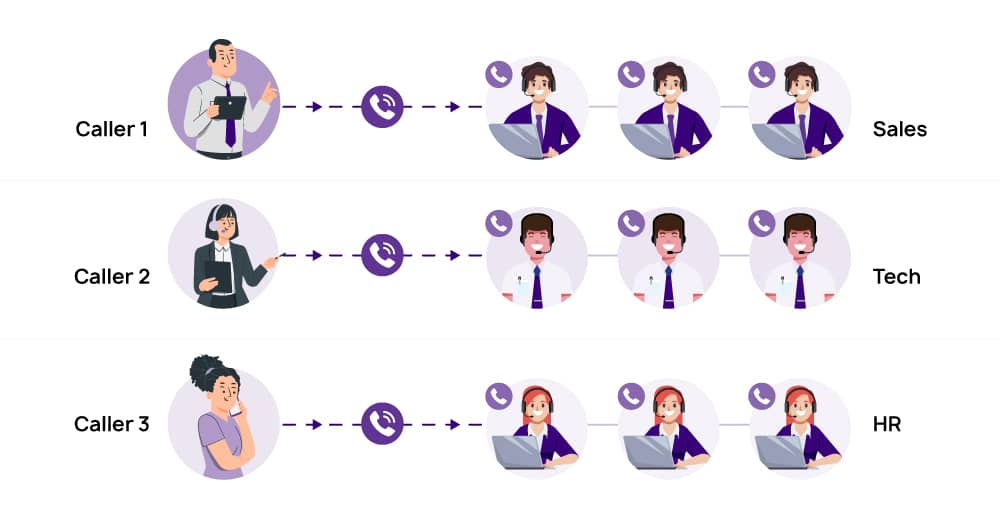
Let’s give an example of a certain scenario. Suppose you are a manager of a call center organization where thousands of incoming calls occur daily. So, now you want to create flexibility in your organization.
That’s where Call Group comes in. You can assign certain groups, such as Tech Support, Sales, and Customer Service. Customers with technical queries can go straight to tech support, and if they want to know about the product, they can reach the sales support team.
👉 You might also like: Direct-Dial-In Numbers: Everything You Need to Know
Top 5 Benefits of Call Group in Your Business
A Call Group makes the inbound call process simple and efficient, decreasing the customer hold time in your business. It can make your business and call centers get efficient and effective workflow.
Some of the Top Benefits of Call Group in your business are as follows:
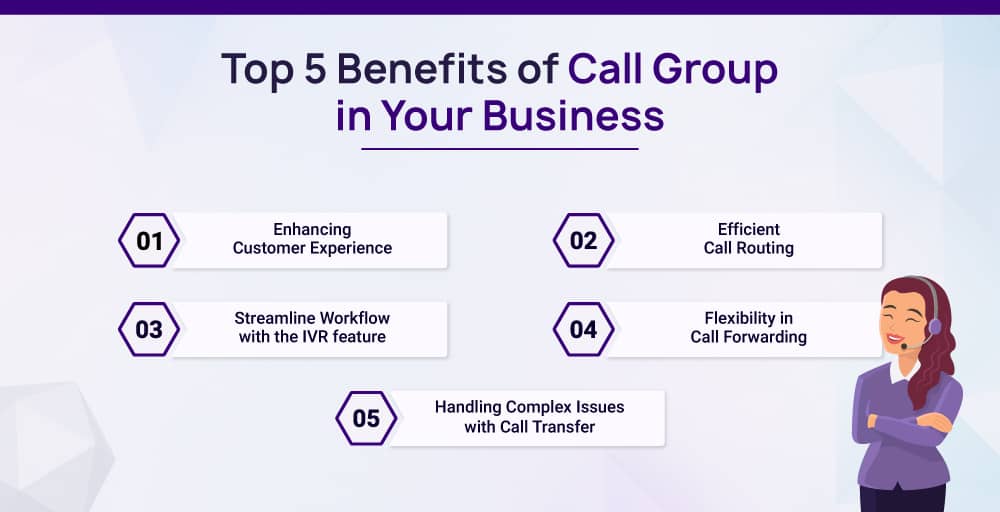
- Enhancing Customer Experience: A good customer experience leads to better customer satisfaction. Call Group’s main benefit is to make sure the customer’s concerns are easily addressed by certain departments within an organization to enhance the customer call experience.
- Efficient Call Routing: You can have an efficient call routing to the specific preferred department. This results in preventing the customer from being transferred multiple times while calling.
- Streamline Workflow with the IVR feature: Call Groups can efficiently and effectively manage the call queuing 📞🔄🕒 or incoming calls of clients with an IVR 🤖feature that can streamline the workflow by automating tasks.
For instance, callers can choose options like Select 1 for Sales, Select 2 for Tech Support, etc. IVR also has adaptability, which helps the caller to select agents according to their language preference.
- Flexibility in Call Forwarding: Call Group can efficiently manage incoming calls to make sure the callers reach the right agent or individual with the Call Forwarding ☎️🔀 feature.
Assigning skill levels to agents within the call group can help to maintain proper flexibility. Also, if all the agents are busy, then there is an alternative voicemail feature to forward the calls.
- Handling Complex Issues with Call Transfer: The Call Transfer feature allows you to easily handle complex customer issues by transferring calls to agents with expertise. This helps avoid unnecessary call delays for your customers.
What are the Different Types of Ringing Patterns in Call Groups?
The various Types of Ringing Patterns serve specific purposes. Understanding the different concepts of call ring patterns for the business organization is necessary for smooth workflow and to enhance the call handling process.
The main motive of ringing patterns in call groups is to deliver optimal customer satisfaction after their call ends. The different types of Ringing Patterns in Call Groups are as follows:
1. Sequential Ringing Pattern
The most common type of ring pattern in a call group that rings one agent at a time is known as the Sequential Ringing Pattern. The inbound calls are directed to the specific group of agents in a predetermined order.
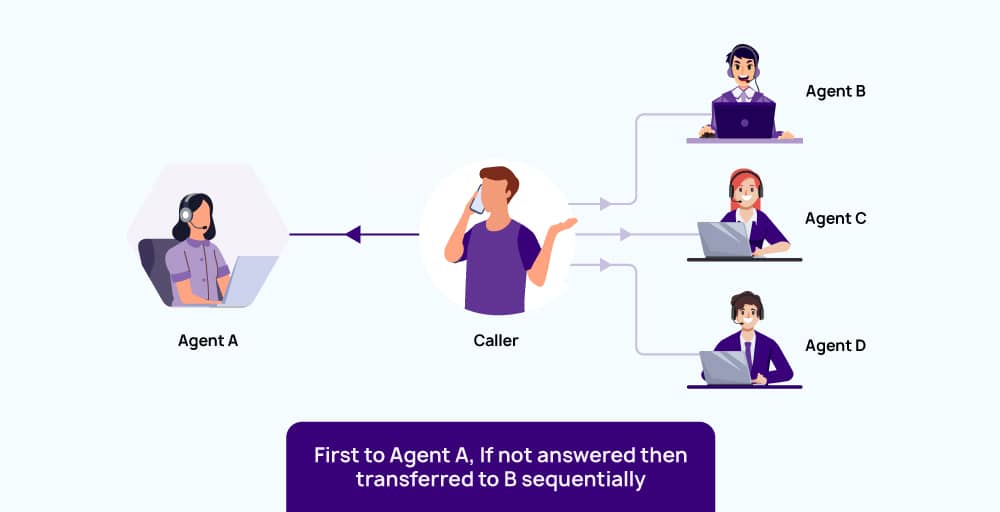
If Agent A is busy or not available, then the call goes to Agent B, and he/she picks up and answers the customer’s queries. If Agent B is also busy, then the call goes to Agent C, and the process continues on. The Sequential Ring Pattern is often used in call centers to ensure the calls are distributed among the group members in an organized manner.
Pros
- The Call Handling process is efficient
- The Inbound calls are fairly distributed among the agents
- Reduced Wait or Hold Time for the Customers
Cons
- Little Complex to implement the Call Routing method
- Uneven Distribution of Workload if an agent takes a longer time to resolve the query of a customer
- Limited Collaboration Opportunities for Team Members
2. Simultaneous Ring Pattern
A Simultaneous Ring Pattern is a call pattern in a Call Group that rings all the agents at the same time. The agent who picks up the call first answers the customer’s queries. The inbound calls are directed to a specific group of agents in an unplanned order.
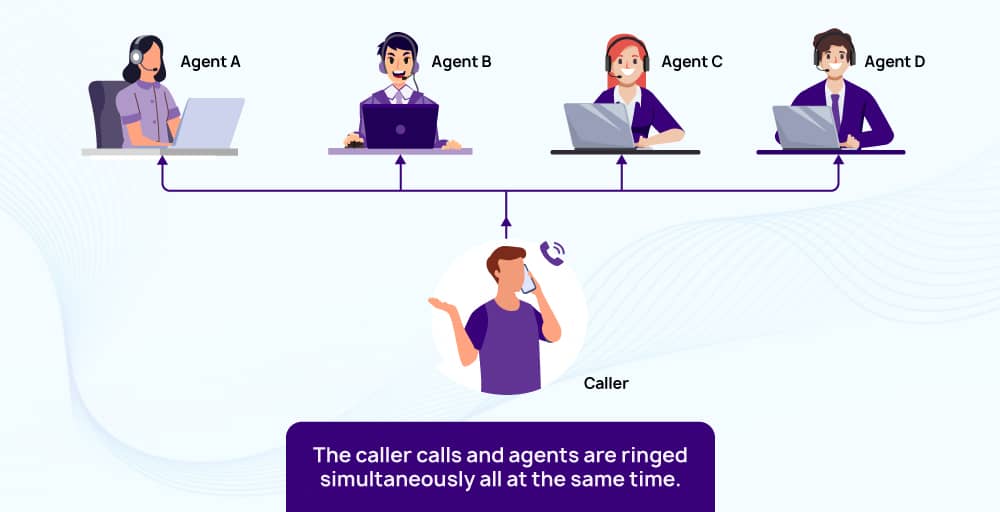
Here, When the caller calls a certain department, and If agents A, C, or D are busy or unavailable, then Agent B can pick up and answer the calls. So customers or clients don’t have to wait long to get their calls answered. Simultaneous Ring Pattern is often used in large-scale businesses where there are large volumes of inbound calls.
Pros
- Quicker Agent Response Time
- Evenly Distribution of Workload
- Redundancy and Reliability to answer the call easily
Cons
- Lots of Noise and Distraction
- Lack of Prioritization of calls to the best available agent
- High Volume of inbound calls may lead to System Overload
3. Circular Ring Pattern
A Circular Ring Pattern is a type of call pattern where the call is ringed just once in a circular pattern, turn by turn, until one of the agents picks and answers the call. It is also known as the Cyclic Ringing Pattern. The calls are distributed among the group of agents in a round-robin fashion.
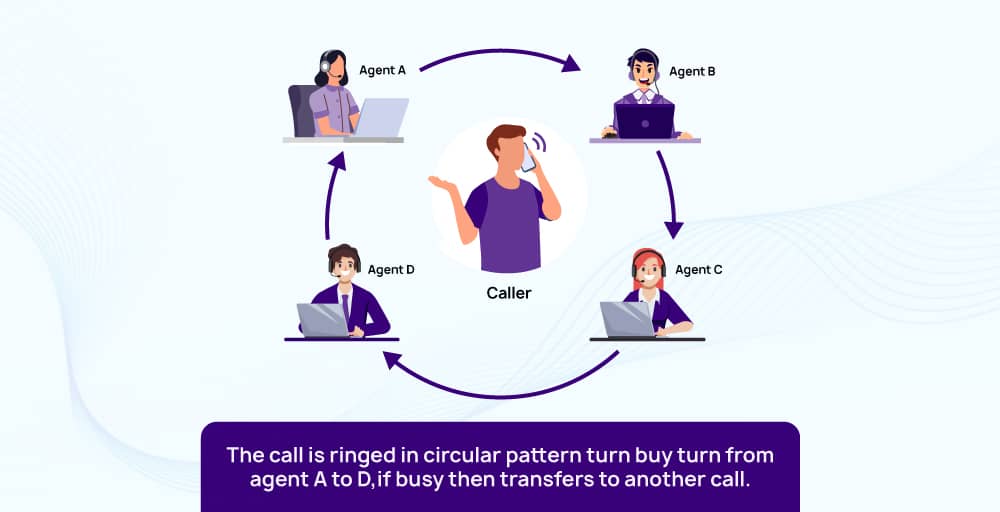
This ring pattern is almost similar to the Sequential Ring Pattern. When the caller calls a certain department, and if Agent A is unavailable or doesn’t answer the call within one turn, then the call is transferred to Agent B, then to C and D in a circular fashion.
Pros
- Fairness to all the agents in Call Handling
- Effective for Small-scaled businesses
- Flexibility in Agent Availability
Cons
- Limited Skill-Based Routing
- Lack of Prioritization of calls to the best available agent
- Challenges in Large-Scaled Businesses
- Uneven Distribution of Workload if the agent takes longer to resolve the query of a customer
🎉 You Might find it interesting: How to Share Business Phone Number with Your Team
How Do I Set up a Call Group for My Business?
You can easily Set up a Call Group for your business with a certain step-by-step process:
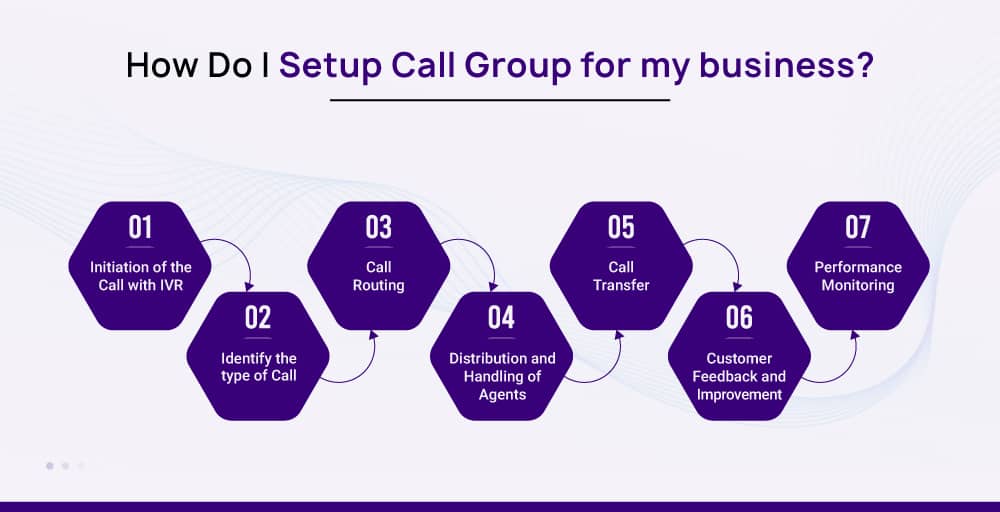
1. Initiation of the Call with IVR
A customer or client first initiates the call by contacting the business phone number. Then, An Interactive Voice Response system can greet the caller with the call menu option.
2. Identify the type of Call
The caller selects a certain option from the call menu, and then the IVR system identifies the type of call and determines the appropriate call group for a specific type of inquiry.
3. Call Routing
The IVR system then directs the call and checks the availability of call agents within the specific call group through the call routing process.
4. Distribution and Handling of Agents
After the process of call routing, the active agents👩💼👨💼 each distribute the volume of incoming calls. Then, the agents handle the calls to address the problems and needs of the customers.
5. Call Transfer
When the agents receive calls, if they feel like the caller’s query is more complex, they can transfer the calls to another call agent with more expertise.
6. Customer Feedback and Improvement
After the call is finished, the customer can give feedback to the certain agent and what things he can improve more on. With this, the agents can do much better in their other calls.
7. Performance Monitoring
With the Call Monitoring feature, you can analyze each agent’s calls. The analysis of each agent through call analytics can help analyze the call performance and also give an overview of areas of improvement.
Call Group Vs Direct Inward Dialing: What are the differences?
Although both Call Group and Direct Inward Dialing are about handling incoming calls, there are some differences between them.
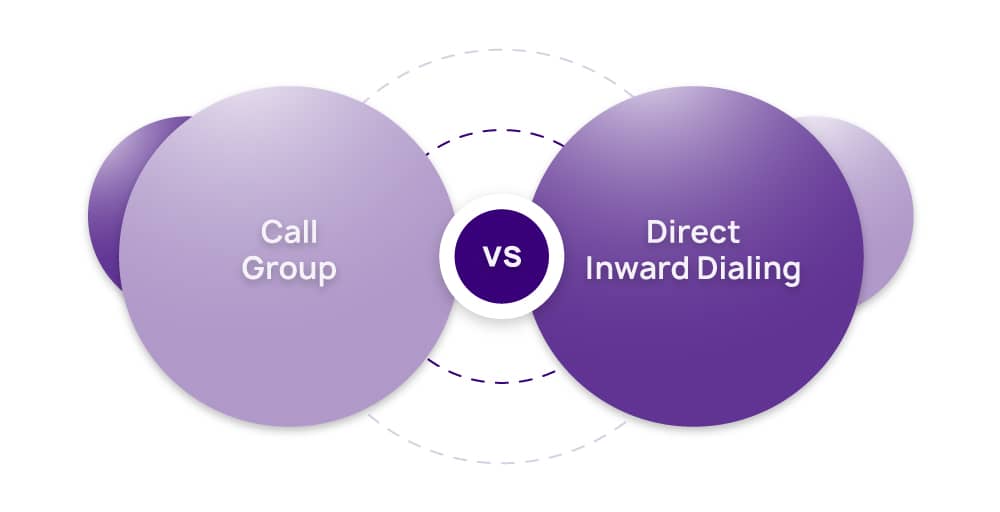
| Call Group | Direct Inward Dialing |
|---|---|
| Calls are directed to a certain business number, then routed to certain departments through IVR in Call Group. | Calls are directed to a certain business number of a department or an individual directly without the need for an IVR in Direct Inward Dialing. |
| It involves a centralized approach where calls are initially directed according to what type of query the customer is facing before being distributed to a specialized team of agents. | It involves a decentralized approach where calls are connected directly to the department and don’t require any intervention in the calling process. |
| There is an Internal Call Transfer based on the specialization of teams. | External Callers can reach their desired destination without the need for an Internal Call Transfer in DID. |
| Cost Structure of the Call Group involves IVR setup, Team Specialization, and Call Routing. | The Cost Structure of Direct Inward Dialing involves DID numbers, call usage fees and monthly subscription fees. |
| It involves more administrative overhead. | It involves less administrative overhead. |
Top 5 Call Group Providers in 2024
If you are looking for the top Call Group service providers in 2024, you have come to the right place.
Below, we have provided you the table along with an explanation of each service provider with its pros and cons.
| Providers | Pricing | Features |
|---|---|---|
| RingCentral | Starts at $30/ month | Shared Numbers, Visual Voicemails |
| Nextiva | Starts at $25/ month | Call Logs, Auto-Attendant |
| RingOver | Starts at $29/ month | Call Forwarding, IVR |
| Ooma | Starts at $20/ month | Call Logs, Voicemail |
| GoTo Connect | Starts at $27/ month | Call Analytics, Video Conferencing |
1. RingCentral
RingCentral is another popular Call Group service provider. It has been providing VoIP services since 1999 and has its headquarters in California, USA. 46 countries trust RingCentral.
RingCentral’s solutions help to operate the business internationally with a global reach. It is a cloud-based collaboration platform designed to meet the business organization’s needs.
🔑 Features
- Video Conferencing
- Visual Voicemails
- Shared Numbers
- Automatic Call Recording
Pros
- Clear Audio Quality
- Easy to Deploy IVR and Call Routing
Cons
- Lack of Conference Call Customization
- Requires a strong internet connection
💲 Pricing
| Plan | Pricing (month/user) |
| Core | $30 |
| Advanced | $35 |
| Ultra | $45 |
2. RingOver
RingOver is another Call Group service provider founded in 2005, with its main headquarters in Paris, France. RingOver provides a range of features to help businesses manage the call group system through better voice communication.
RingOver’s solutions allow all types of businesses to set up and manage call groups with different types of ringing patterns.
🔑 Features
- Access to Local Numbers from 65 countries
- Call Logs
- IVR
- Call Forwarding
Pros
- Good Support System
- Easy to use
- Intuitive User Interface
Cons
- Expensive in Pricing
- Requires a good internet connection
💲 Pricing
- Smart: $29 month/user
- Business: $54 month/user
- Advanced: $64 month/user
| Plan | Pricing (month/user) |
| Smart | $29 |
| Business | $54 |
| Advanced | $64 |
3. Nextiva
Nextiva is another Call Group service provider that has been providing VoIP services since 2006 with its headquarters in Scottsdale, US. Nextiva provides cloud telephony service with flexibility and scalability.
Nextiva’s scalable and flexible features help to simplify business operations and manage call group systems with different VoIP features.
🔑 Features
- Video Conferencing
- Call Routing
- Auto-Attendant
- Call Logs
Pros
- Easy to setup
- User-friendly Portal
Cons
- Only Desktop and Mobile Platform
- Not Suitable for large-scale businesses
💲 Pricing
- Essential: $25 month/user
- Professional: $30 month/user
- Enterprise: $40 month/user
| Plan | Pricing (month/user) |
| Essential | $25 |
| Professional | $30 |
| Enterprise | $40 |
4. Ooma
Ooma is another Call Group service provider in this list. It has been providing various VoIP services since 2004 AD and has its headquarters in California, United States. The Ooma business phone system is designed to enable users to communicate effectively and efficiently with their colleagues through ring groups.

Ooma’s solutions are primarily focused on small and middle-scale businesses.
🔑 Features
- Call Queuing
- Call Logs
- Call Forwarding
- Voicemail
Pros
- Convenient to use
- Good Sound Quality
Cons
- Call Recording is limited to up to 3 hours only with no option to pause and resume.
- Lack of Internal Group Chats or No Member to Member communication.
💲Pricing
| Plan | Pricing (month/user) |
| Essentials | $20 |
| Pro | $25 |
| Pro Plus | $30 |
5. GoTo Connect
GoTo Connect is the last Call Group service provider in this list. It has been providing various VoIP services since 2019 AD and has its headquarters in Boston, Massachusetts. GoTo Connect is a scalable business phone system designed to offer businesses comprehensive solutions for voice, video, and collaboration.

GoTo Connect’s solutions are primarily focused on small and middle-scale businesses.
🔑 Features
- Video Conferencing
- Call Analytics and Reporting
- Call Forwarding
- Voicemail
Pros
- Good User Interface
- Instant Messaging
Cons
- Not Suitable for Large Businesses
- Lack of Do Not Disturb Mode Feature for Clients and Members
💲Pricing
| Plan | Pricing (month/user) |
| Basic | $27 |
| Standard | $32 |
| Enterprise | Contact the Sales Team |
Top 5 Factors to Consider Before Implementing Call Groups
There are best tips to be considered before you implement call groups in your organization or call center are as follows.
- Matching Agents/ Employees Skill: One of the first and main factors to consider before implementing call groups is to make sure the agents or employees are assigned to certain departments according to their skills.
If an HR support agent is assigned to the IT department, the skills don’t match. So, this should be properly managed while implementing call groups.
- Faster VoIP Technology and Better Infrastructure: Customers and clients want faster service these days. If VoIP 📞 technology exists but the process is slower, customers will hang up their phones and call your competitors for further queries.
So, before implementing call groups, you need to ensure faster VoIP technology and better facility infrastructure.
- Availability of Number of Call Volumes and Agents: Another major factor to consider is the availability of several call volumes and agents. Make sure the call volumes and number of agents are equally available. If there are more agents, but the call volumes are less, the agents might feel bored in the workplace.
On the other hand, if there is a high volume of calls and very few agents, then the agents might feel monotonous. So, this should be managed properly.
- Privacy and Security: Privacy and Security🔏 are the most important factors for call groups to ensure proper end-to-end call encryption, which prevents unauthorized call access, and data encryption, which helps to protect stored data like voicemail recordings and call logs.
Also, the agents should be given proper training on protecting the client’s information and making it confidential.
- Task Hierarchy and Proper Management: Another important factor to consider in the Call Group is Task Hierarchy, where the team leader and supervisor assign each department a role and responsibility. A rotation strategy should also be maintained for proper management.
✅ Check out Automatic Call Distribution Software for Call Centers
Instantly Set up Call Groups with KrispCall’s Inbound Call Center Solutions
KrispCall’s Cloud-Based Inbound Call Center Solutions helps to automate the agent’s incoming calls with ease. Enjoy the multiple phones simultaneously ringing in your business organization by setting up call groups and getting various features like call recording, call monitoring, and advanced IVR features.
You can set up Call Groups instantly with KrispCall’s Inbound Call Center Solutions by following the step-by-step process
Step 1. Sign up with KrispCall, then sign in to the Dashboard
Step 2. Choose the country from which you want to purchase the number.
Step 3. Buy phone numbers and submit the documents (if necessary).
Step 4. Invite agents to the workspace, then share phone numbers.
Step 5. Integrate interactive voice response and automatic call distribution features into your system. (for bulk inbound calls).
You can get KrispCall at just $15 per month, and the cost is cheaper at just $12 per month if you pay annually. So, hurry up and instantly set up call groups to satisfy your customers and clients and increase work productivity in the business.
Conclusion
Call Group is the most important factor for making your business communication better. It is a process where you can connect with your clients and customers with ease through the management of all inbound calls and streamlining the workflow communication in the business.
With Call Groups, you can utilize an advanced IVR system for efficient call routing, call monitoring, and quality assurance. You can quickly identify the caller’s needs and route them to the appropriate department through the IVR system for a proper call-routing process.
There are various VoIP service providers in the market. If you are looking for the best provider, then consider choosing KrispCall. KrispCall’s VoIP features can grow your brand and expand your business globally. So, Book a free KrispCall demo now to see whether your business meets the requirements.
FAQs
Are Call Group and Ring Group the same?
Yes, Call Group and Ring Group have the same meaning, which is simultaneously ringed or sequentially ringed in a specific order when a call comes in.
What is Call Group used for?
A Call Group is used to ensure all the inbound calls are distributed efficiently and promptly among the call agents in certain customer service or sales departments.
Where is Call Group mainly used?
Call Group is mainly used in business organizations and call centers, including sales, HR, accounts, and customer service representative departments.





